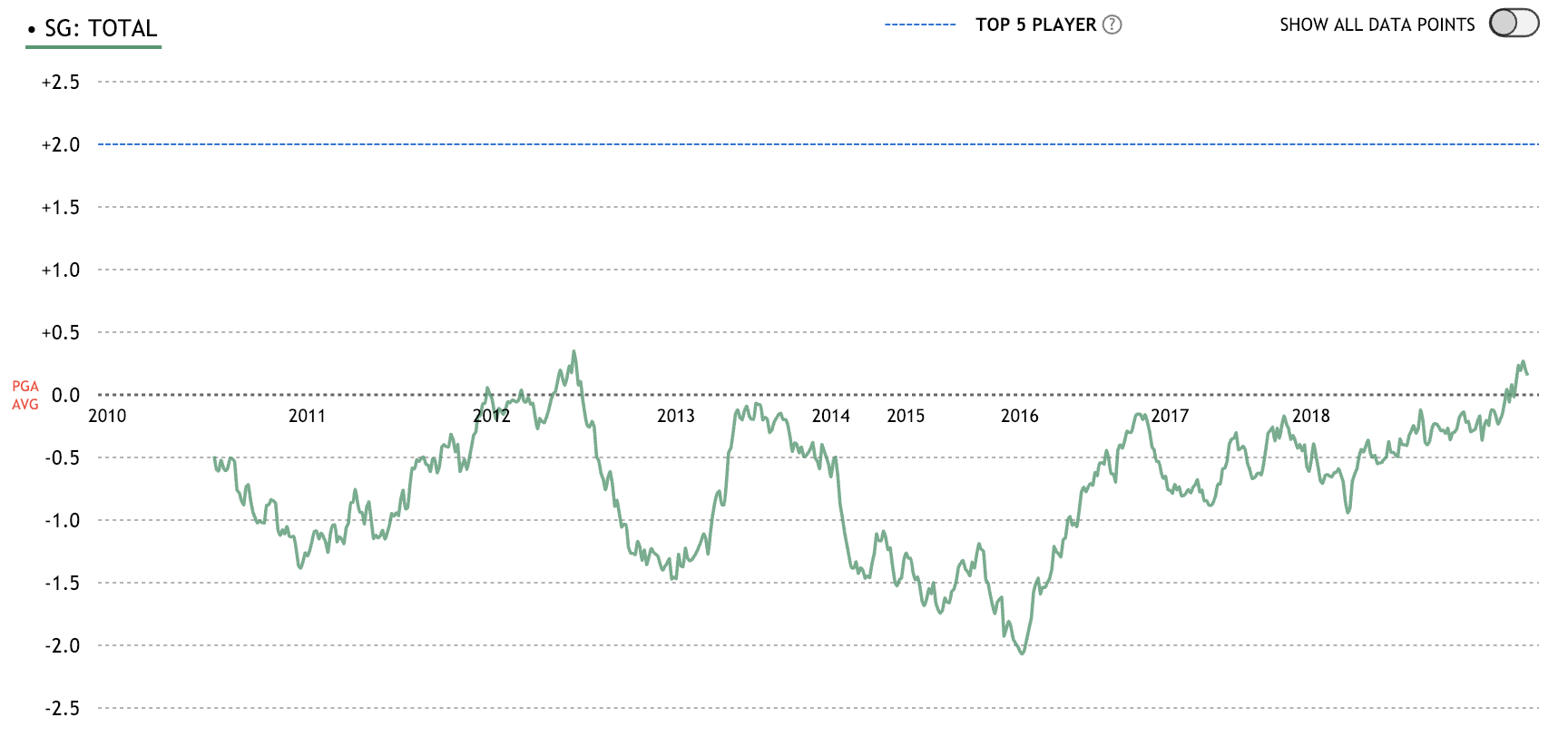• DG Betting Blog
With golf media focusing primarily on the PGA Tour circuit, it is easy to forget about the many talented players grinding on the Web.com tour. While the average skill level of golfers on the Web.com is certainly lower than its PGA Tour counterpart (we estimate the difference as roughly 1-1.3 strokes per round in terms of average player quality), a select few players each year show consistent signs of PGA Tour calibre performance in golf’s minor league. Players who have blossomed off the Web.com Tour recently are Keith Mitchell, Cameron Champ, Sam Ryder, and Denny McCarthy, just to name a few.
Let’s focus on Denny McCarthy for a moment. He finished off his 2017 Web.com campaign with finishes of T19, T31, T9, T17, T12. These aren’t finishes that will get you much media attention, but fortunately our model doesn’t care where you play. Our “true” strokes-gained measure, which is the primary input into our predictive model, estimated these performances to be roughly 1 stroke better per round than what we would expect from an average PGA Tour player.
While McCarthy struggled in 2018 on the PGA TOUR, he managed to regain his card through the Web.com Finals, and has since registered 3 Top 20 (and 2 Top 10) finishes in 14 starts this season. Until recently, McCarthy was consistently one of the biggest positive discrepancies between our model and the market, but in the last couple weeks the market has taken notice of Denny’s solid play.
So why is this relevant to this week?
Our model seems to have identified a Web.com player whose solid play of late has gone largely unnoticed. He’s reeled off 3 T20s in his last 5 starts, and nabbed a victory earlier this year. Going further back, this player has performed at a level just a shade below that of an average PGA Tour player (i.e. true strokes-gained of 0) over his last 100 rounds. His name? Journeyman Mark Anderson. The plot below shows his true strokes-gained 50-round moving average since the start of his career (includes all rounds on the PGA and Web.com Tours):
Let’s focus on Denny McCarthy for a moment. He finished off his 2017 Web.com campaign with finishes of T19, T31, T9, T17, T12. These aren’t finishes that will get you much media attention, but fortunately our model doesn’t care where you play. Our “true” strokes-gained measure, which is the primary input into our predictive model, estimated these performances to be roughly 1 stroke better per round than what we would expect from an average PGA Tour player.
While McCarthy struggled in 2018 on the PGA TOUR, he managed to regain his card through the Web.com Finals, and has since registered 3 Top 20 (and 2 Top 10) finishes in 14 starts this season. Until recently, McCarthy was consistently one of the biggest positive discrepancies between our model and the market, but in the last couple weeks the market has taken notice of Denny’s solid play.
So why is this relevant to this week?
Our model seems to have identified a Web.com player whose solid play of late has gone largely unnoticed. He’s reeled off 3 T20s in his last 5 starts, and nabbed a victory earlier this year. Going further back, this player has performed at a level just a shade below that of an average PGA Tour player (i.e. true strokes-gained of 0) over his last 100 rounds. His name? Journeyman Mark Anderson. The plot below shows his true strokes-gained 50-round moving average since the start of his career (includes all rounds on the PGA and Web.com Tours):
Mark Anderson true strokes-gained 50-round moving average:
Anderson’s consistency over the past year, along with some stellar recent form, have vaulted him up to 139th in the DG rankings (ahead of Andrew Landry and Joaquin Niemann, for reference). Our new “Scratch” betting tool shows that books are offering Top 20 odds for Anderson with implied probabilities ranging from 3 to 6 percent. In contrast, our model, which incorporates his Web.com performances, has his Top 20 probability at just under 11 percent. This makes Anderson one of the biggest positive expected value plays of the week.
Scratch Finish Tool:
The one caveat is that Anderson has not played since February. Even if you think this layoff warrants a minor negative bump to his baseline prediction due to “rust”, Anderson should still likely be considered as a strong longshot Top 20 play this week. The baseline abilities of the golfers which our model gives a 4-5% chances of a T20 this week are around -0.6 strokes per round, while Anderson’s ability is estimated at just above 0. This leaves room for a reasonable amount of error in Anderson’s prediction while still maintaining positive expected value.
Live Leaderboards
PGA Tour
round 1 —

